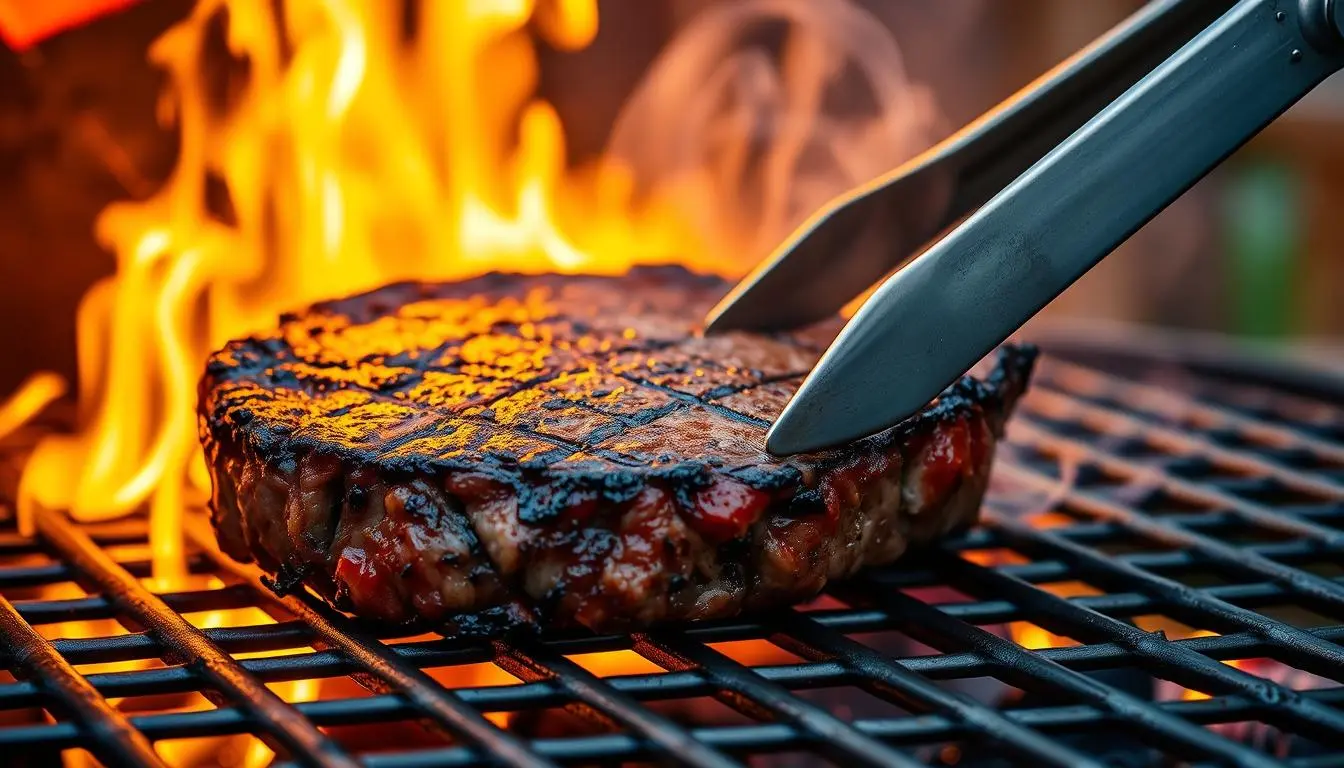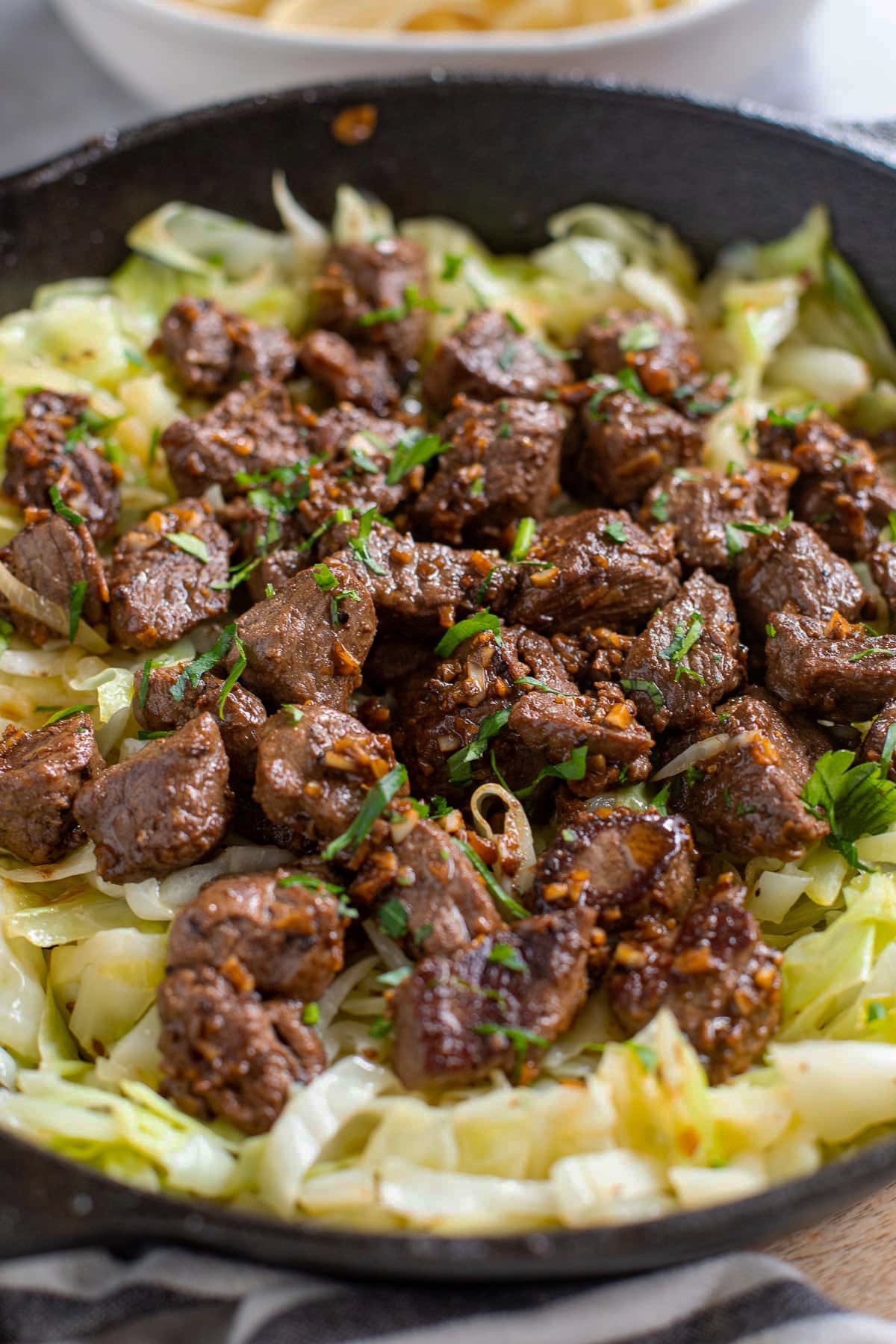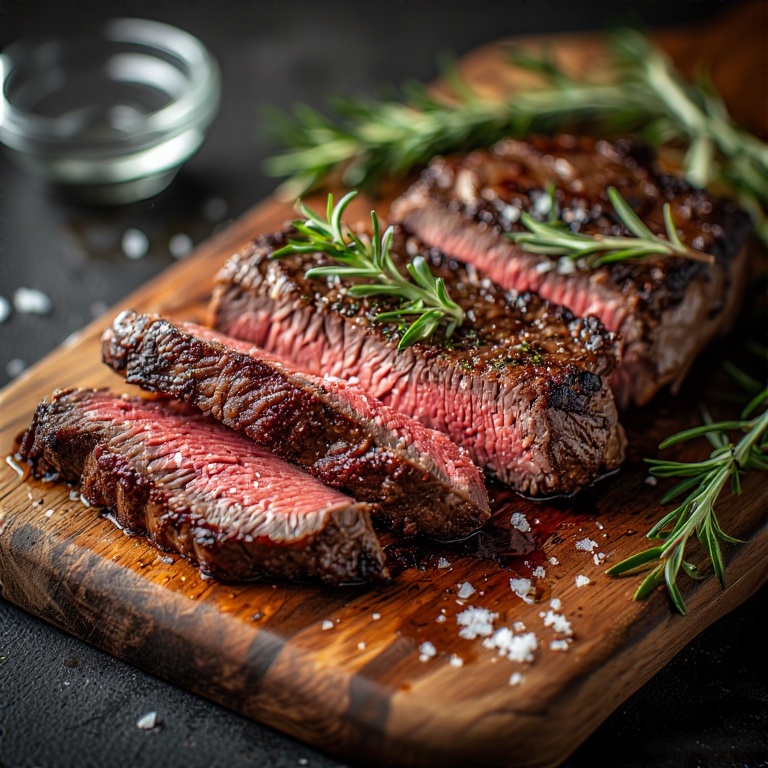Ribeye steak recipe perfection doesn’t require a gourmet kitchen—just the right technique. If you’ve ever craved a juicy, tender steak with a golden crust and bold flavor, you’re in the right place. I still remember the first time I got that perfect sear on a ribeye at home—no grill, no stress, just sizzling satisfaction in a cast-iron skillet. With this guide, you’ll learn how to bring steakhouse-quality results straight to your stovetop, any night of the week.
Did you know that ribeye is one of the most flavorful cuts of beef? By following this comprehensive guide, you’ll learn not only how to select the best ribeye but also master various cooking methods to elevate your dinner experience.
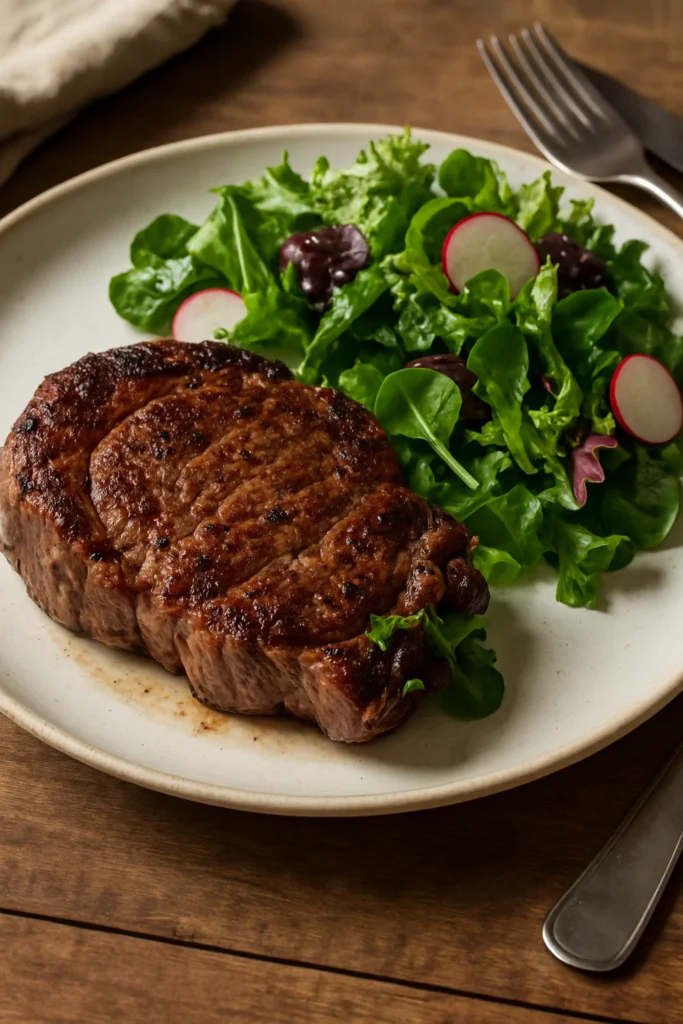
Key Takeaways
- Understand the unique characteristics of ribeye steak.
- Learn how to choose a high-quality cut based on marbling.
- Discover various cooking methods: grilling, pan-searing, and oven-roasting.
- Get insights into the best seasonings for delicious steak cooking.
- Explore ideal side dishes that complement ribeye steak.
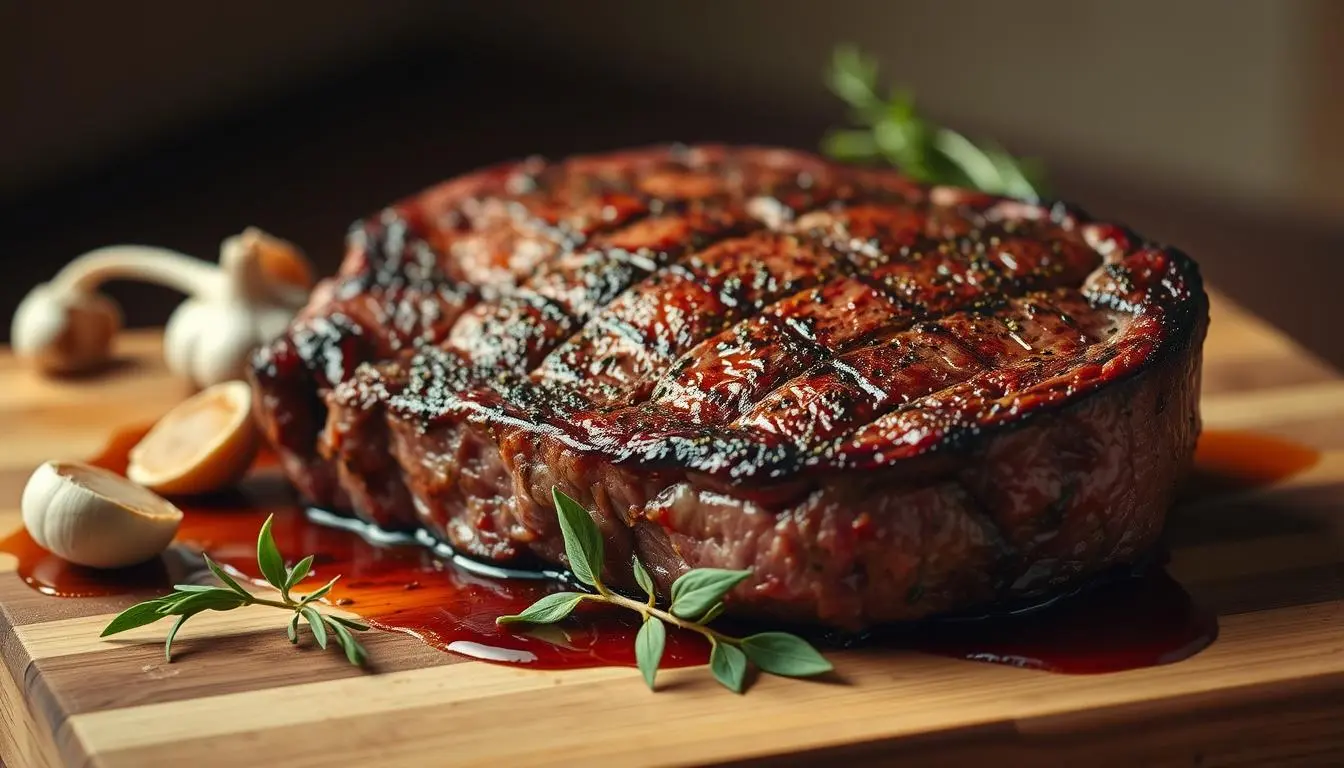
Ribeye Steak
Ingredients
Equipment
Method
- Remove steaks from the fridge and let them come to room temperature (30–45 minutes).
- Season both sides with salt, pepper, and garlic powder if using.
- Heat a cast-iron skillet over high heat until very hot (450–500°F).
- Add olive oil, then gently place the steaks in the skillet.
- Sear for 2–3 minutes per side until a crust forms.
- Add butter, garlic, and herbs. Baste the steak with the melted butter for 1–2 minutes.
- Transfer the skillet to a preheated oven at 400°F (if needed) and cook to desired doneness (135°F for medium-rare).
- Remove and let rest for 5–10 minutes, covered loosely with foil.
- Serve with mashed potatoes, grilled asparagus, or your favorite sides.
Notes
For best results, use a well-marbled ribeye steak at least 1 inch thick. Allow the steak to come to room temperature before cooking for even doneness. Always rest the steak after cooking to retain juices and enhance flavor. You can finish the steak in the oven if it’s especially thick or bone-in. Customize your seasoning with herbs, butter, or a dry rub to suit your taste.
Understanding Ribeye Steak
Ribeye steak is a top choice for steak enthusiasts thanks to its juicy marbling, unmatched tenderness, and deep, beefy flavor. Understanding the various cuts of ribeye can elevate your cooking experience and help you serve restaurant-quality steak at home.
What Makes Ribeye Special?
Ribeye steak is loved for its rich fat marbling, which locks in moisture and delivers bold, juicy flavor with every bite. The fat inside the meat, called marbling, adds to the flavor. When cooked right, a ribeye steak is so tender it almost melts in your mouth.
Boneless vs. Bone-In Ribeye
Choosing between boneless and bone-in ribeye steak comes down to personal preference and cooking method. While boneless ribeye steaks are perfect for quick, hassle-free meals, bone-in cuts offer deeper flavor and a juicier bite for those who enjoy a richer dining experience. Bone-in steaks, on the other hand, have a richer flavor because of the bone.
| Type of Ribeye | Characteristics | Benefits |
|---|---|---|
| Boneless Ribeye Steak | Easy to cook and slice; less connective tissue | Convenient for quick meals and easy portioning |
| Bone-In Ribeye | Richer flavor; enjoyable presentation | Enhances taste due to bone influence; great for sharing |
Choosing the Perfect Ribeye Steak
When picking a ribeye steak, knowing the quality of the cut is key. The quality of marbling and the steak’s thickness are important. They both impact the steak’s taste and tenderness.
Identifying Quality Marbling
Marbling is the fat in the meat. It makes the steak juicy and flavorful. Look for a lot of intramuscular fat, as it melts and adds richness.
The USDA grading system helps judge marbling quality. Prime has the most, followed by Choice and Select. Choose at least Choice for a great meal.
Determining Your Ideal Thickness
Thickness is crucial for cooking the ribeye right. Aim for 1.5 to 2 inches thick. This technique creates a flavorful crust on the ribeye steak while locking in its juicy interior.
Thinner steaks cook too fast, while too thick ones might not cook evenly. Think about these when picking your ribeye steak.
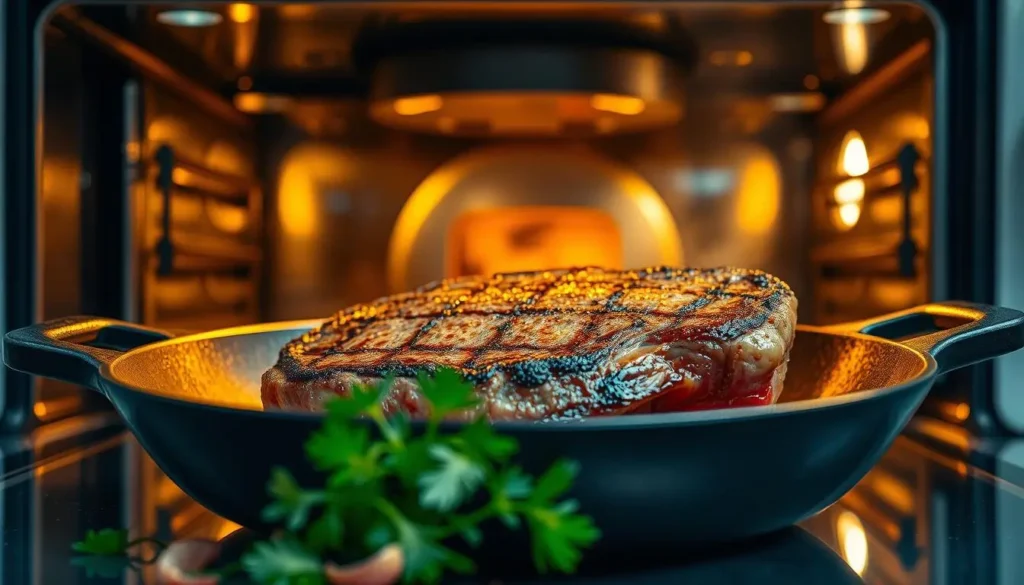
Best Ribeye Seasoning
Seasoning is key to making ribeye steak taste amazing. The right seasoning can turn a good meal into an unforgettable one. Let’s look at some top seasonings and how to make a tasty homemade dry rub for ribeye.
Essential Seasonings for Ribeye
For the best ribeye spices, keep it simple. Here are the top picks:
- Adding salt brings out the ribeye steak’s rich, beefy flavor while creating a golden, flavorful crust on the outside.
- Black Pepper: Adds a nice kick and balances the steak’s richness.
- Garlic Powder: Brings a strong flavor that goes well with beef.
- Fresh Rosemary: Adds a fresh, aromatic touch that complements the steak’s juices.
Using these ingredients wisely will make your ribeye taste incredible.
Creating Your Own Ribeye Dry Rub
Homemade dry rubs for ribeye steak allow you to personalize the taste. Begin with classic salt and pepper, then layer in garlic powder, paprika, or herbs to suit your preference.Aim for a mix that coats the steak well. Here’s a simple recipe to get you started:
| Ingredient | Amount |
|---|---|
| Salt | 2 tablespoons |
| Black Pepper | 1 tablespoon |
| Garlic Powder | 1 teaspoon |
| Fresh Rosemary (chopped) | 1 teaspoon |
Apply this dry rub to both sides of the steak before cooking. It will make every bite rich and satisfying.
Pan-Seared Ribeye: Step-by-Step
Cooking a pan-seared ribeye can really boost your cooking skills. This method teaches you how to get a delicious crust and a tender inside. It’s all about using a cast-iron skillet, which keeps heat well for perfect steak searing.
Preparing Your Cast-Iron Skillet
First, heat your cast-iron skillet on high. Let it get very hot, which is key for caramelizing. While it heats up, use a high smoke point oil like canola or avocado oil to grease the bottom. This helps prevent burning and gets you that great crust on your steak.
Achieving the Perfect Sear
Once your skillet is sizzling hot, carefully place the ribeye steak in the pan to begin searing. Make sure the steaks have enough room so each one gets a good sear. You’ll know it’s working when you hear a nice sizzle.
Let it sear for 4-5 minutes on one side. Flip it only when it has a golden crust. This careful timing makes your steak taste and feel amazing.
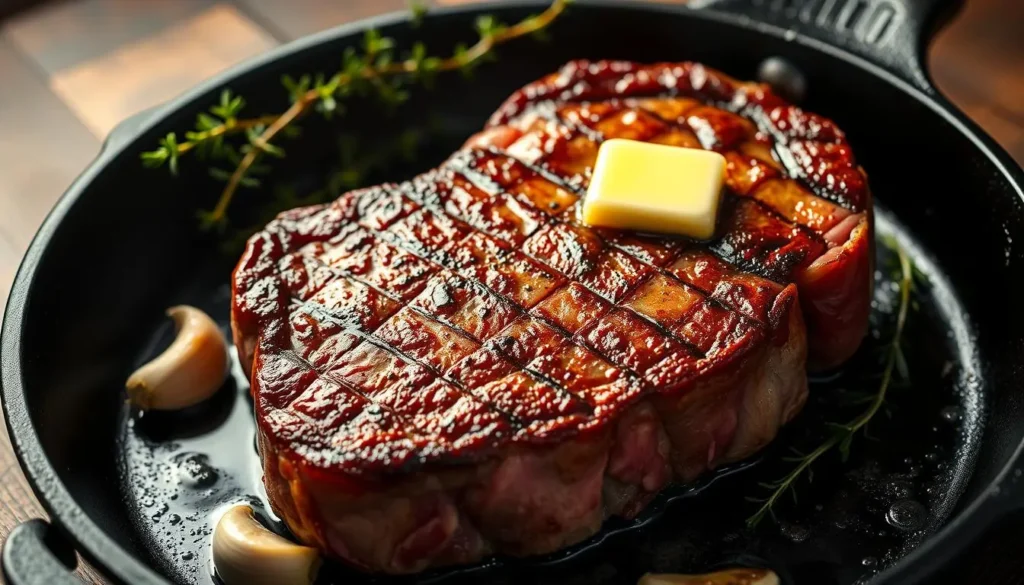
Grilled Ribeye: Tips for Success
Grilling ribeye steak can take your dining experience to new levels. Learning how to prepare your grill and control the steak’s temperature is key. With these skills, you can make sure your ribeye steaks are both tasty and juicy.
Preparing the Grill
First, make sure your grill is clean. This prevents unwanted flavors from sticking to your steak. Next, oil the grill grates to help the steak release easily after cooking.
Preheat your grill to a high temperature. This is important for getting a seared exterior and keeping the steak moist. The direct heat helps create that crispy crust everyone loves.
Monitoring the Grill Temperature
Controlling the steak’s temperature is crucial for a perfect ribeye. Use a thermometer to check the grill’s temperature often. Maintain a skillet temperature between 450°F and 500°F to sear the ribeye quickly and lock in maximum flavor.
Adjust the grill settings as needed. This prevents burning the outside while keeping the inside just right.
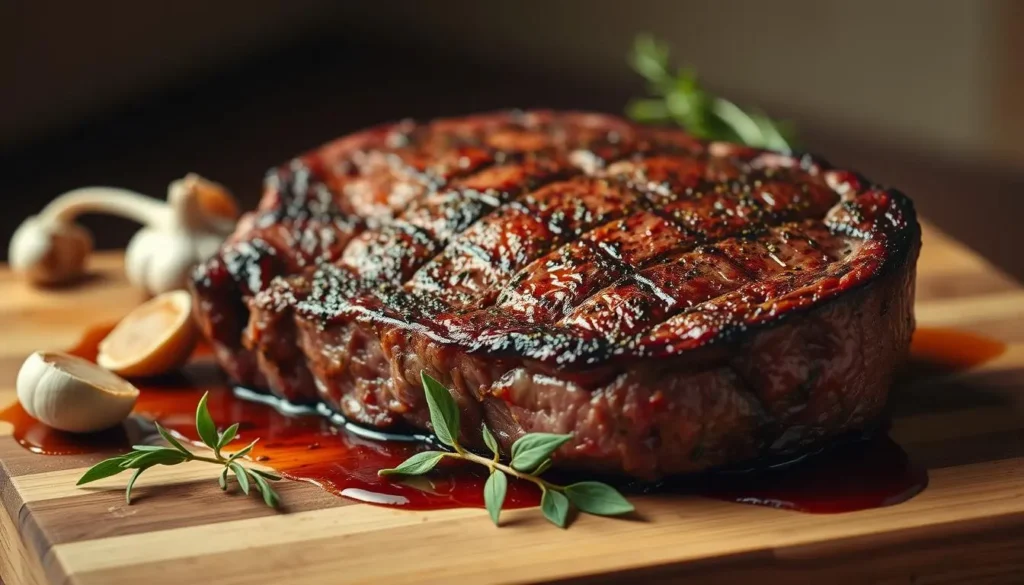
With these tips, you’re on your way to grilling ribeye steak like a pro. Enjoy the process and the delicious results!
Ribeye Steak in the Oven: A Foolproof Method
Looking for a reliable way to cook ribeye steak? Cooking it in the oven is a great choice. It ensures even heat, keeping the steak juicy and flavorful. Start by heating your oven to 400°F (200°C) while you get your steak ready.
Preparing for an Oven Finish
Begin by searing your ribeye steak in a hot cast-iron skillet on the stovetop, about 2–3 minutes per side. This quick sear locks in juices and creates a flavorful, golden-brown crust. Once both sides are well-seared, transfer the skillet directly to a preheated oven to finish cooking to your preferred level of doneness.
This method avoids the need for extra pans. It makes the transition to oven cooking easy.
Using a Meat Thermometer for Accurate Doneness
A meat thermometer is key to getting your steak just right. Stick it into the thickest part of the steak. For a perfect medium-rare, aim for 135°F (57°C).
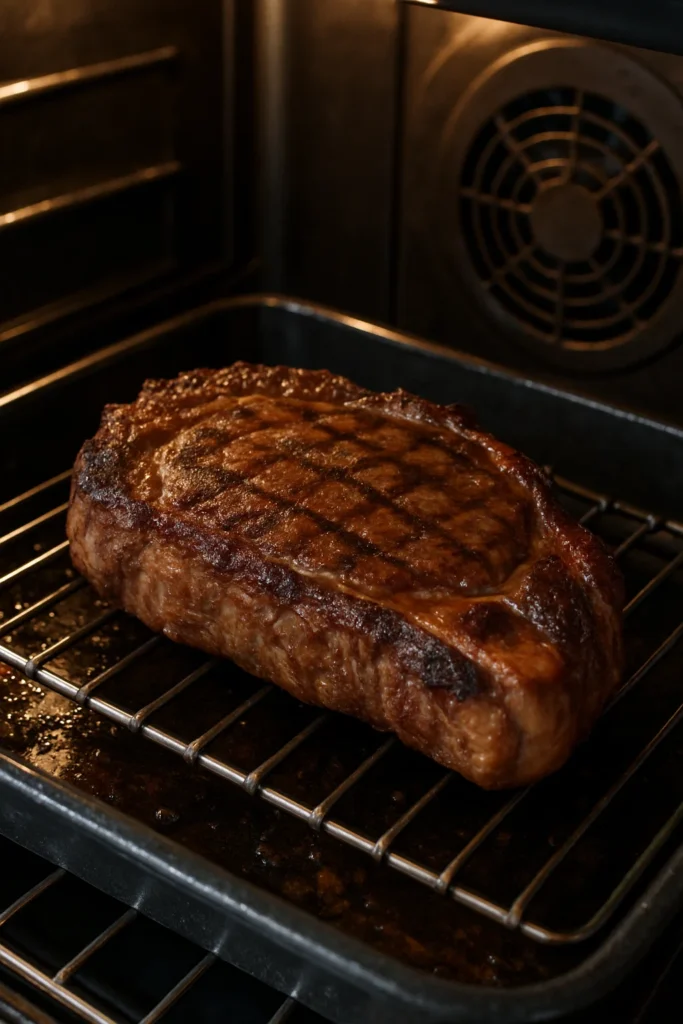
| Doneness Level | Internal Temperature (°F) | Best Cooking Method |
|---|---|---|
| Rare | 120-125 | Oven |
| Medium-Rare | 130-135 | Oven |
| Medium | 140-145 | Oven |
| Medium-Well | 150-155 | Oven |
| Well Done | 160+ | Oven |
Internal Temperature for Medium-Rare Ribeye
Getting the perfect ribeye internal temperature is key for a tasty steak. For a medium-rare ribeye, the ideal internal temperature is 135°F (57°C). Knowing the right cooking times helps you enjoy your ribeye at its best. This section will guide you on cooking times and how to check if it’s done.
Recommended Cooking Times
The cooking times for a medium-rare ribeye vary based on your method and steak thickness. For pan-searing, cook each side for 4-5 minutes. Grilling times might be similar but can change with heat and steak thickness.
Checking for Doneness with a Thermometer
Using a meat thermometer to check steak doneness is essential. Stick the thermometer into the thickest part of the steak for an accurate reading. Pull the steak off heat when it’s close to 135°F. This allows it to slightly warm up while resting.
Resting Time After Cooking
Resting your ribeye steak is a key step that many overlook. It’s important for the flavor and tenderness of your meat. When you cook a steak, the juices move to the surface.
By letting it rest, these juices spread evenly throughout the meat. This makes each bite more flavorful. Knowing why resting is important can make your ribeye taste better.
Importance of Resting Your Ribeye
Immediately slicing into a cooked ribeye can lose those tasty juices. The resting time is crucial. It lets the meat fibers relax, making each bite juicier.
This simple step can turn a good steak into an amazing one.
How Long to Let Your Steak Rest
For the best taste, let your ribeye rest for 5-10 minutes. Cover it with foil to keep it warm. This short time is key for great flavor and texture.
Juicy Ribeye Steak Tips
Preparing a juicy ribeye steak requires the right techniques. Choosing the right cooking fat and avoiding common mistakes are key. Let’s dive into these important tips for a delicious steak.
Choosing the Right Cooking Fat
Choosing the right cooking fat is crucial for flavor and sear. High smoke-point oils like grapeseed oil or clarified butter are great. They prevent burning and enhance the beef’s taste. Regular butter burns easily at high temperatures, making it less good for grilling or pan-searing.
Avoiding Common Mistakes
Several mistakes can make your ribeye less juicy. Here are some tips to avoid them:
- Bringing your ribeye to room temperature before searing allows for even cooking and a juicier, more consistent result.
- For the best crust and juiciness, let your ribeye steak sear on each side without flipping too often. This helps lock in moisture and flavor.
- For accurate results, use a meat thermometer to test doneness. Time alone can vary—temperature is the key to a perfectly cooked ribeye.
- Don’t rush cooking. A juicy ribeye needs patience to stay moist.
Remember these tips to improve your steak cooking. You’ll enjoy a perfectly juicy ribeye with every meal.
Ideal Side Dishes for Ribeye Steak
Choosing the right side dishes can make your ribeye steak meal even better. Look for sides that bring out the steak’s flavors and add texture and variety. Mashed potatoes and grilled asparagus are great choices, each adding something special to your meal.
Pairing with Mashed Potatoes
Mashed potatoes are a perfect match for ribeye steak. Their creamy texture balances the steak’s savory taste.Want next-level mashed potatoes? Add roasted garlic or sour cream for extra creaminess and bold flavor that pairs perfectly with ribeye steak.
Complementing with Grilled Asparagus
Grilled asparagus is a fresh and crisp side that pairs well with ribeye steak. The smoky flavor of grilled asparagus pairs beautifully with the richness of ribeye steak. Adding a drizzle of lemon vinaigrette brightens the dish and enhances the overall balance of flavors on the plate.
Ribeye Steak Recipe: Perfectly Cooked Every Time
To make the perfect ribeye steak, you need to know a few tricks. This recipe will make sure every bite is full of flavor and tender. Start by picking a high-quality ribeye steak that you like. Then, season it, cook it, and finish it with a compound butter for steak.
Bringing It All Together in Your Recipe
Here’s how to make your ribeye steak:
- Choose a ribeye steak with good marbling, ideally around 1.5 inches thick.
- For bold flavor, coat your ribeye steak with a generous layer of salt, pepper, or a custom dry rub perfect for building a delicious crust when seared.
- Make sure your grill or skillet is fully heated to a high temperature before adding the ribeye steak—this locks in juices and builds bold flavor.
- Cook the steak for about 4-5 minutes on each side, achieving a nice sear.
- Use a meat thermometer to confirm the desired internal temperature, aiming for medium-rare at 130°F.
- Rest the steak for at least 5 minutes before serving to retain juices.
Suggested Compound Butter Topping
Make your ribeye dinner even better with a compound butter. Mix softened butter with fresh herbs like parsley, thyme, and a clove of garlic. Spread it on your steak just before serving. It will melt and add a rich, savory flavor.
Conclusion
In this ribeye steak cooking summary, you’ve learned key techniques to improve your steak-making skills. You now know how to pick the best cut and cook it perfectly. These tips will help you make a juicy, delicious ribeye every time.
Don’t forget the importance of seasoning, searing, and letting the steak rest. These perfect steak tips are crucial for a great ribeye. They make your steak taste amazing. You can use a cast-iron skillet or a grill to bring out the best in the ribeye.
Using this ribeye cooking guide will make you a better cook and help you love this meat even more. So, get your ingredients ready, heat up your grill or pan, and enjoy cooking a perfect ribeye steak. It’s a journey to mastering a top-notch beef experience.
FAQ
What’s the Best Way to Cook Ribeye Steak for Maximum Flavor?
You can cook ribeye steak in several ways. Pan-searing, grilling, or oven-roasting are popular choices. Each method brings out different flavors and textures. Pan-searing gives a tasty crust, while grilling adds a smoky taste.
How do I season my ribeye steak for maximum flavor?
For great flavor, use simple seasonings like salt, black pepper, garlic powder, and fresh herbs. You can also make a dry rub for even flavor.
How thick should my ribeye steak be for optimal cooking?
Aim for a steak that’s 1.5 to 2 inches thick. This thickness keeps juices in and cooks evenly, making the steak juicy.
What internal temperature should I aim for a medium-rare ribeye?
To achieve a perfect medium-rare ribeye, cook until the internal temperature reaches 135°F (57°C). Always use a meat thermometer for accuracy and optimal results.
Why is resting important after cooking my ribeye steak?
Resting your ribeye steak for 5 to 10 minutes ensures the juices settle and stay locked inside, resulting in a more flavorful, tender bite. Use foil to keep it warm while it rests.
What are some delicious side dishes to serve with ribeye steak?
Pair your perfectly cooked ribeye with classic sides like rich mashed potatoes, smoky grilled asparagus, and savory garlic mushrooms for a well-rounded steakhouse-style dinner.These sides complement the steak’s richness and make a complete meal.
Can I cook ribeye steak in the oven?
Yes, oven cooking is great for even heat. Sear the steak in a skillet first, then bake at 400°F (200°C) until it’s done.
What are the common mistakes to avoid when cooking ribeye steak?
Don’t skip letting the steak come to room temperature before cooking. Also, avoid flipping it too often. Both can cause uneven cooking and a less juicy steak.
What type of oil should I use for pan-searing ribeye steak?
Use oils with a high smoke point like canola or avocado oil for pan-searing. These oils can handle high heat without burning, giving a perfect sear.
🥩 How Did Your Ribeye Steak Turn Out?
We’d love to hear how your ribeye steak came out! Did you go for a smoky sear in a cast-iron skillet, add a garlic herb butter on top, or try something bold with a dry rub? Tell us your twist in the comments—your feedback helps us bring more juicy, flavorful steak recipes to life.
If you enjoyed this ribeye steak recipe, be sure to check out even more ways to cook it—pan-seared, grilled, or oven-finished—plus side dishes, seasoning tips, and steakhouse-style dinner ideas on our official website .
🔥 Let’s keep steak night bold, delicious, and unforgettable!

